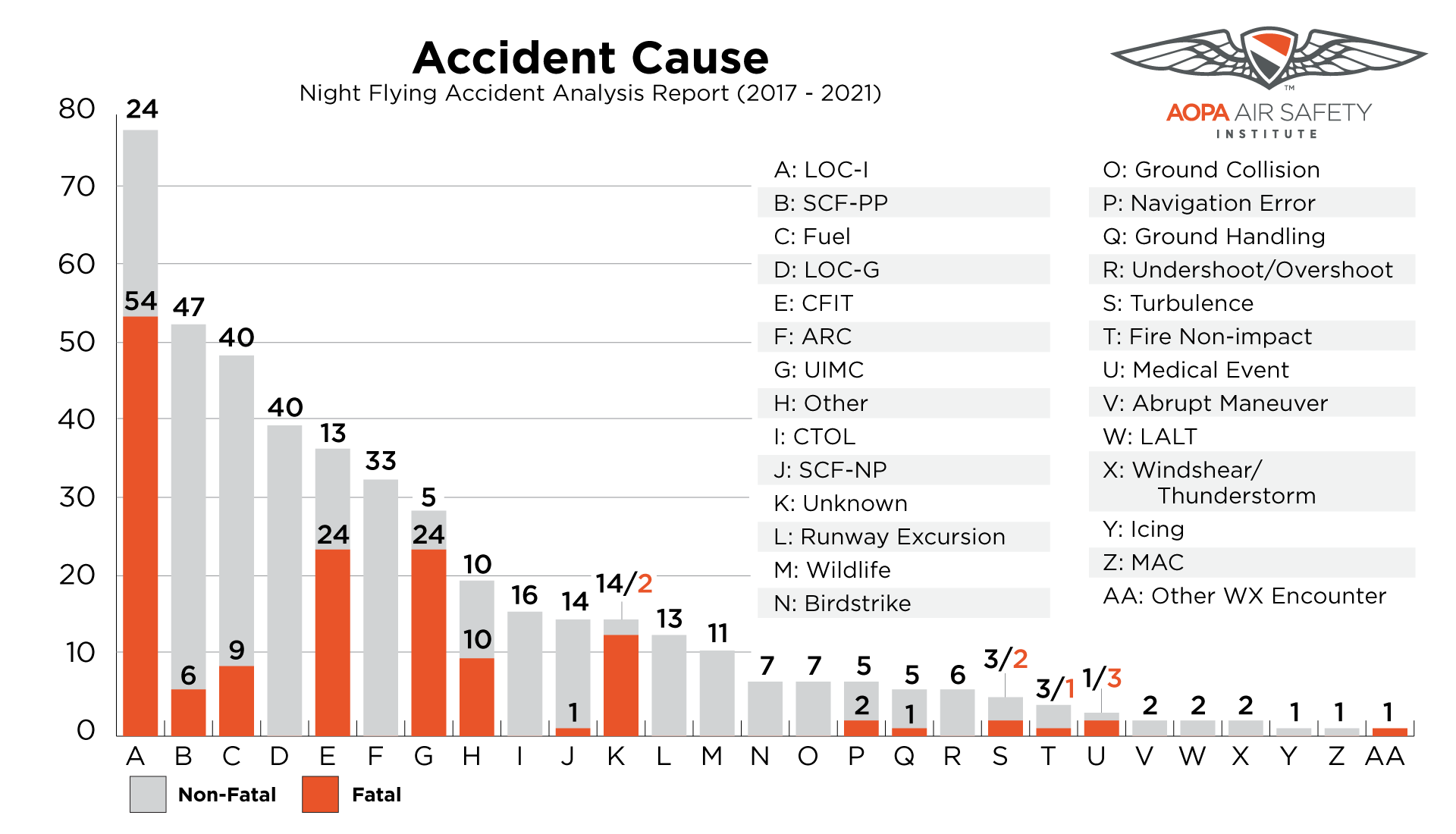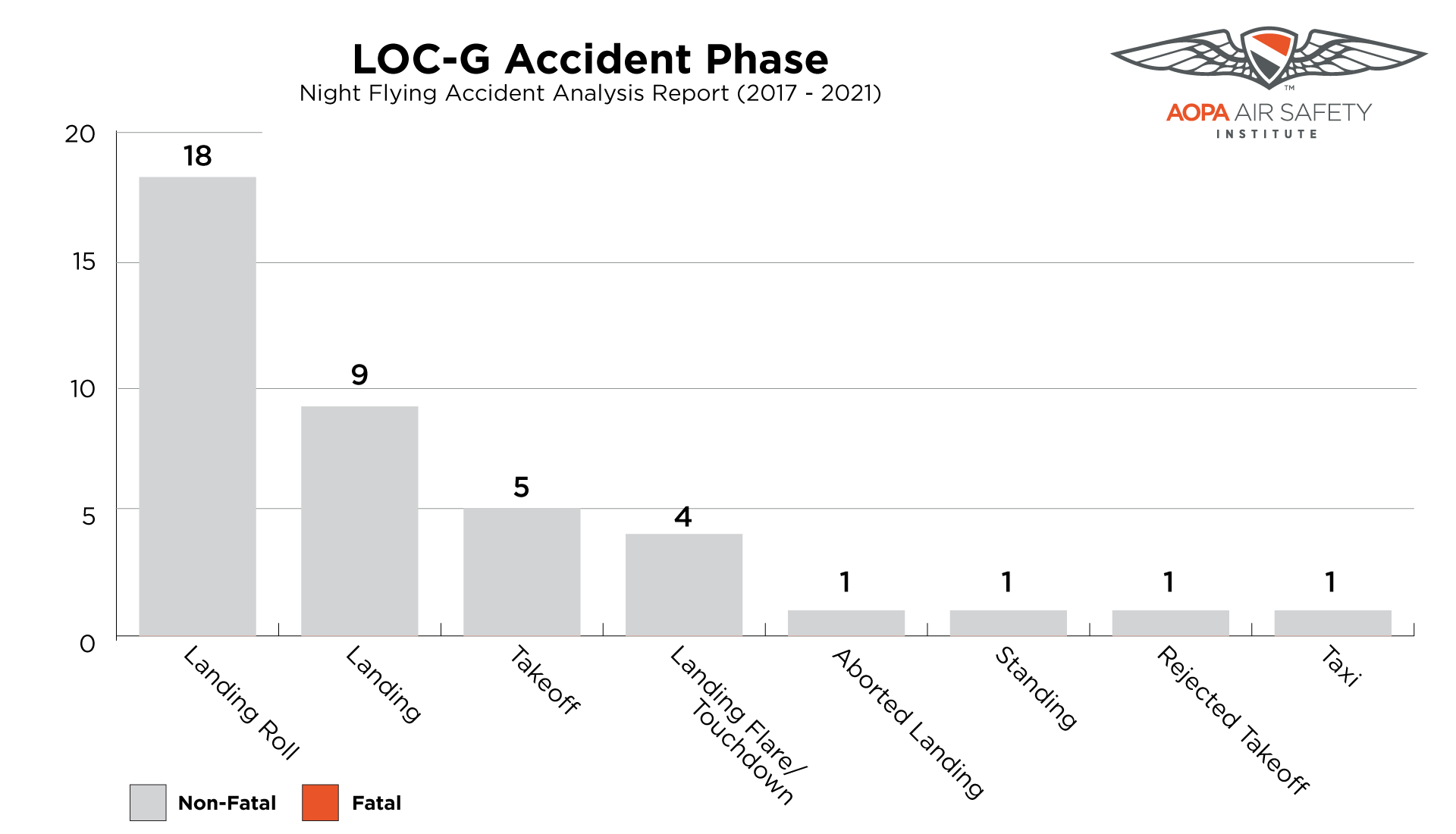ACCIDENT CAUSES

Extracting fatal LOC-I accidents, the en route phase of flight leads with the most accidents (18) and highest lethality—a measure of total accidents to fatal accidents—(95 percent).
A number of factors contribute to accident outcomes, but the NTSB determines a singular event among these factors—the defining event—and all accidents have one. A look at these defining events reveals LOC-I leads accident causes with 78 followed by system component failure powerplant (SCF-PP) with 53 accidents. Third, fuel-related, accounts for 49 accidents. Fourth and rounding out approximately half of the accidents is LOC-G with 40 accidents.

Defining Events
LOC-I includes stalls and spins resulting from pilot input (e.g., exceeding the critical angle of attack) as well as failed pilot inputs to maintain control. These actions are cases where configuration of the airframe or ice buildup leads to an inability to control the aircraft.
SCF-PP is best thought of as engine and/or propeller failure. Causes listed may include additional factors outside of the pilot’s control—for example, mistakes made by maintenance providers.
Fuel-related events include exhaustion, starvation/mismanagement, contamination, and wrong fuel. In cases where the wrong fuel led to engine failure (e.g., detonation), fuel is the defining event, not SCF-PP.
LOC-G differs from LOC-I as all the events take place when the aircraft is on the ground. In cases where the aircraft is transitioning during takeoff or landing, the NTSB tries to determine where the event originated. If the aircraft was already swerving off the runway and made it into the air, albeit briefly, the NTSB would probably view this as LOC-G instead of LOC-I, as the flight was not under control during the portion before the aircraft left the surface.
Loss of Control in Flight
LOC-I Analysis
LOC-I accidents most often occurred during the en route phase (19) followed by VFR approach and initial climb phases (both 16). IFR approach and maneuvering tied at eight accidents each. Extracting fatal LOC-I accidents, the en route phase of flight leads with the most accidents (18) and highest lethality—a measure of total accidents to fatal accidents—(95 percent). Initial climb was second (12) followed by VFR approach (8). The main LOC-I accident cause was stall/spin (20).

The main LOC-I accident cause was stall/spin (20).
System Component Failure – Powerplant
SCF-PP Analysis
SCF-PP accidents, following LOC-I, occur most often during the en route phase (30). Initial climb (9) and VFR approach (4) rank second and third, respectively. Examining fatal accidents only, SCF-PP shifts from the second-highest cause of accidents to the seventh highest cause. This shift provides evidence that powerplant failures are largely survivable. Pilots who become distracted or fixated on the issue instead of managing the problem increase their risk of fatality. Only seven of the 53 accidents were the result of maintenance errors (e.g., lack of inspection or service). Pilots’ failure to identify problems during preflight was a theme within SCF-PP accidents as well.
.png)
Examining fatal accidents only, SCF-PP shifts from the second highest cause of accidents to the seventh highest cause. This shift provides evidence that powerplant failures are largely survivable.
Fuel Related
Fuel Analysis
Fuel-related accidents, again, follow LOC-I and SCF-PP occurring during the en route phase of flight (25) followed by VFR approach (7). Fuel accidents share similarities with SCF-PP when examining fatal accidents. These similarities can be attributed to how the problem presents itself; fuel issues affect the engine and pilots would respond as they would to an engine issue. Only nine fuel-related accidents were fatal. The leading factor—and unforgivable sin in aviation—for fuel-related accidents was exhaustion (23). Starvation (17) was second followed by carburetor icing (5). Exhaustion happens when the aircraft runs out of fuel, in contrast to starvation, which occurs when fuel remains but something—perhaps pilot-related (e.g., improper fuel system management)—prevents the fuel from reaching the engine. Contamination (2) is minimally concerning given the difficulty of properly inspecting fuel at night.

Fuel-related events include exhaustion, starvation/mismanagement, contamination, and wrong fuel. In cases where the wrong fuel led to engine failure (e.g., detonation), fuel is the defining event, not SCF-PP.
Loss of Control on Ground
LOC-G
LOC-G occurs within expected phases given the location of the accident (i.e., on the ground). Takeoff and landing are the dominate phases. Specifically, aircraft on the landing roll account for 45 percent of all LOC-G accidents. No fatal accidents occurred during the five-year period. This is largely attributed to the aircraft being on the ground at low airspeed. These two factors significantly reduce impact forces. Loss of directional control—usually caused by lack of proper rudder and aileron inputs (especially in crosswind conditions)—is a major contributor to LOC-G accidents.

Loss of directional control—usually caused by lack of proper rudder and aileron inputs (especially in crosswind conditions)—is a major contributor to LOC-G accidents.
Other Factors
Spatial disorientation
Pilots flying at night are susceptible to spatial disorientation. This type of disorientation incapacitates pilots and prevents them from correctly manipulating the controls. Flight during daylight in VMC removes the likelihood of spatial disorientation, whereas night often removes the visible horizon. There are times, however, when the horizon is visible but pilots confuse lights on the ground with lights from the starry sky above, an illusion known as “ground light confusion.” Forty one accidents involved spatial disorientation (8 percent of all night accidents). Astonishingly, 39 of these accidents were fatal, roughly 26 percent of all fatal night accidents. More than one-quarter of night fatal accidents involve some form of spatial disorientation. The level of incapacitation from spatial disorientation is misunderstood as something that can easily be overcome. In these cases, pilots rarely survived once succumbing to the overpowering sensation that is spatial disorientation.
Midair Collisions
Seemingly absent from this analysis are midair collisions. Changes in the physiology of the eye’s detection of movement during low-light conditions would highlight the importance of a thorough scan. However, only one midair collision occurred during the five-year period, at dusk. While midair collisions occur with less frequency than often thought, reduced activity may be the driving factor. The wide adoption and installation of navigation and anti-collision lights coupled with ADS-B traffic alerts may provide additional rationale for dwindling numbers.
Forty one accidents involved spatial disorientation (8 percent of all night accidents). Astonishingly, 39 of these accidents were fatal, roughly 26 percent of all fatal night accidents.
Next: Conclusions and RecommendationsLOC-I Case Study
In the case of a Cessna R172 (NTSB Accident Report CEN19FA155), the non-instrument-rated pilot departed on a VFR cross-country flight in VMC to a remote area devoid of illumination. The pilot had more than 700 hours, but rarely flew at night. With minimal celestial light and no surface light the pilot developed spatial disorientation and lost control of the aircraft.
SCF-PP Case Study
In the case of an engine failure during an en route climb (NTSB Accident Report CEN18FA053), an ATP and pilot-rated passenger attempted a diversion to the only airport within gliding distance. The airport was undergoing construction and thus closed, and all pilot-controlled lighting systems were turned off. The pilot was unable to identify the airport and overflew it. During the turn back the aircraft impacted a tree.
Fuel Case Study
While fuel exhaustion dominates fuel-related accidents, starvation is an area where attention can prevent accidents. The pilot of a Piper PA–32R-301T (NTSB Accident Report ERA20FA026) reported loss of engine power to air traffic control during a visual straight-in approach for landing. The aircraft impacted trees short of the runway and caught fire. The pilot failed to properly seat the fuel selector control lever that consequently stopped fuel from flowing to the engine.